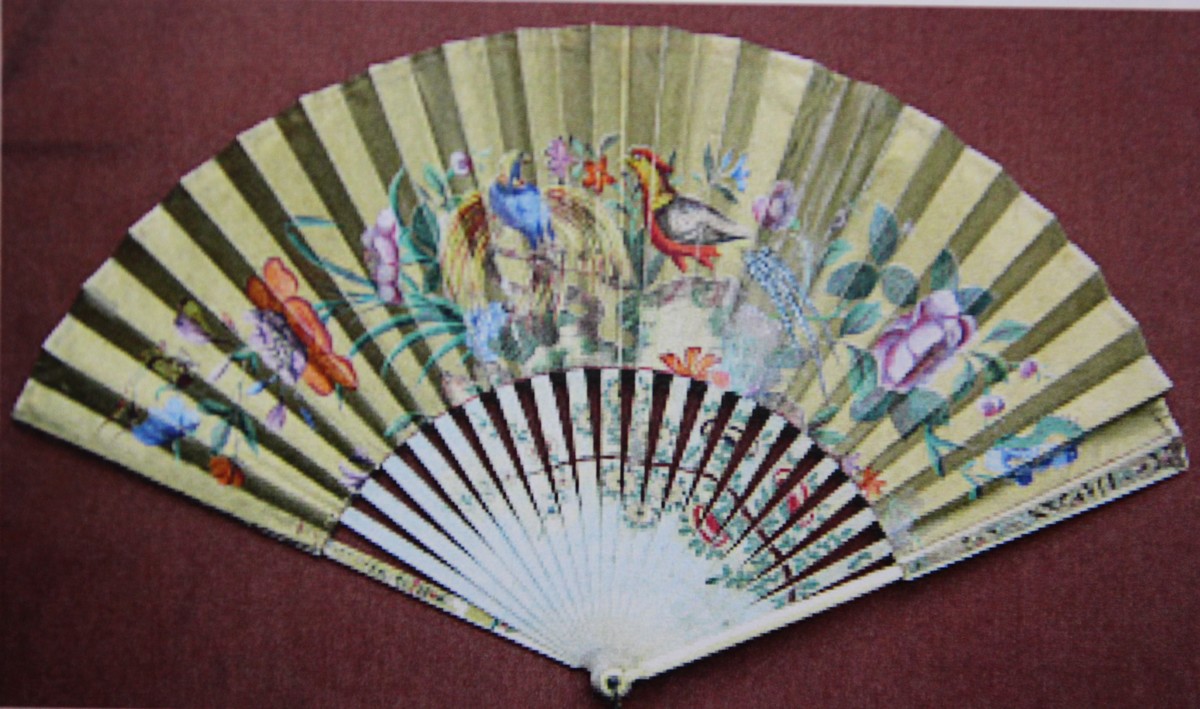Cette page en français
Even
after having collected hand fans for decades, it happens that we keep
illusions (youth of heart perhaps?), that we have doubts (wisdom of old
age?) or, worse, that we no longer remember when and where we saw an
object (advanced decrepitude?). Anyway, we would like to hear the
opinion of our kind visitors, so long neglected. The fan that we show
here was presented in the recent sale where we acquired it as a "fan decorated with Chinese characters and birds in the branches on the reverse" with "sculpted and openwork bone branches. 28x5 cm. End 19th early 20th century".
When the auctioneers are presented in television programs as experts,
those who frequent the auction rooms laugh softly (including the "commissaires de justice" themselves, a new name for the "commissaires-priseurs"
now incorporated into the mass of bailiffs). We all know that such
omniscience would only be possible for God, who, as far as we know, has
never taken any other profession here below than that of carpenter. We
therefore do not reproach the person who thus described the fan that we
show below.
Let's take a look at its monture first. Note that the french word "monture" means the sticks and the two guards. Automatic translators often turn it to "mount", not knowing that mount is the traditional English word for leaf! Here, the monture is unquestionably from
the mid-18th century, and its workmanship as well as the size of 28.5
cm suggest an English production... or for the English market. It must
indeed be remembered that in France in particular the fan makers
adapted their production to the tastes of the countries to which they
exported their goods. Georgina Letourmy, p. 91 of his 2006 thesis
(which can be consulted in the library),
recalled what a professional of the time said: "In Paris, fans are made
which imitate those of foreign countries so perfectly that the workers
themselves cannot distinguish them". (BnF, Western manuscripts, Joly de Fleury collection 2018 fol 261). And the author of these lines, in his own 2015 thesis (p. 91-92, available online), wrote:
As soon as 760, the Journal de Commerce
(Brussels) advertised the sieur Guyot, "manufacturer of fans in Paris,
rue Quincampoix", who claimed to have "...a factory of all kinds of
fans, both in wood and in bone, ivory & mother-of-pearl, as well as
all kinds of leaves painted and printed in the manner of Paris, &
in imitation of those of England, of which a part is superior to them
for the design & the beauty of the illumination " (Journal du Commerce 1760, p. 195).
Another ad from the same publication two years later told us that
"… M. Modeste Roussel (who will be Modesto Rous
when in Spain!), Manufacturer of fans in Paris […] excels in the new
taste he gives to his works, mainly in rich fans, such as fans of
mother-of-pearl, ivory, molded tortoiseshell and not molded, for
Holland, Germany and Spain. He directs the heights for each country. He
also makes the common fans in bone and Indies wood, & gives them
the most fashionable taste, all at fair price. […] He supplies, as his
father-in-law did, the Court of Spain and Portugal” (Journal de Commerce 1762, p. 172).
So it is quite obvious that if the style and the dimensions say
something about the date of making, it is sometimes very difficult to
know where a fan was manufactured, especially when it is an object of
English taste, at a time when Anglomania was beginning to spread in the
French society. Be that as it may, everyone will agree that the monture you have in front of you
cannot be "end of the 19th century -
beginning of the 20th century".
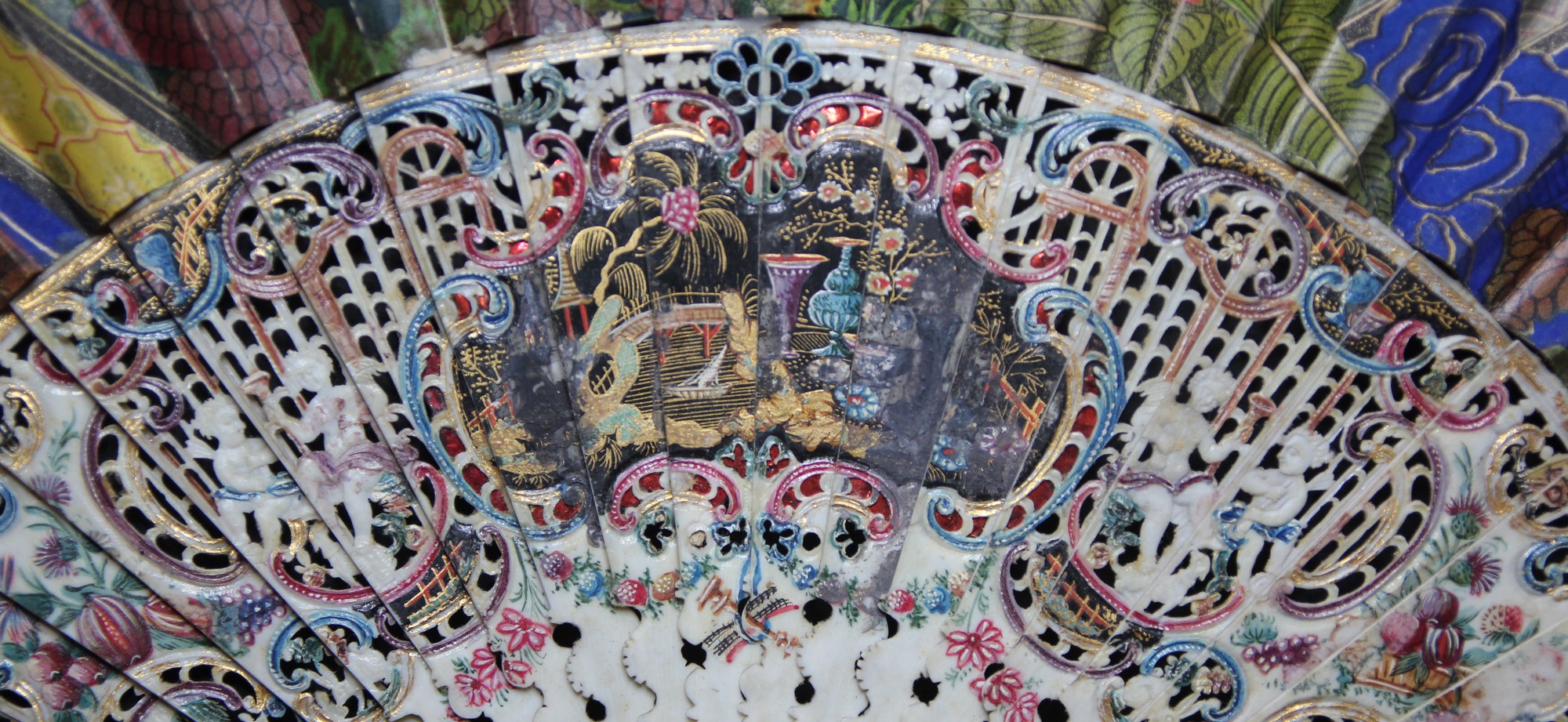
But what leads us to ask you questions is the leaf. For sure, this one
represents a palace scene characteristic of the so-called "Mandarin" or
sometimes "Canton" fans, or even "mille
visages" (in French... English speaking persons, more realistic,
speak of "one-hundred faces ").
The best study on this subject is in our opinion that carried out by
our late friend Thomas DeLeo. We will borrow some images and thoughts
from him below.
If one generally associates with the "mandarin" fan the figures with
applied ivory heads, these motifs seem to take up models applied before
the fans on porcelain or on wooden objects, such as screens, on which
the expression "one hundred faces" would have been used first (cf.
Brigitte Nicolas, Un brin de panache,
Musée de la Compagnie des Indes, 2019, p.78). The images below are
taken from Thomas DeLeo ("The Mandarin Pattern"; FANA Journal Fall 2020, p. 43
-porcelain, c. 1720- and p. 45 -screen, late 18th century-).
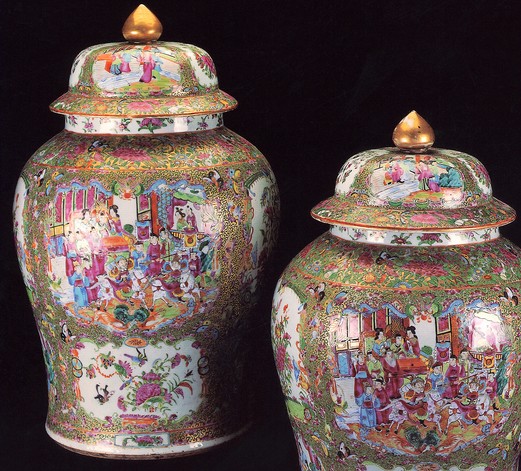 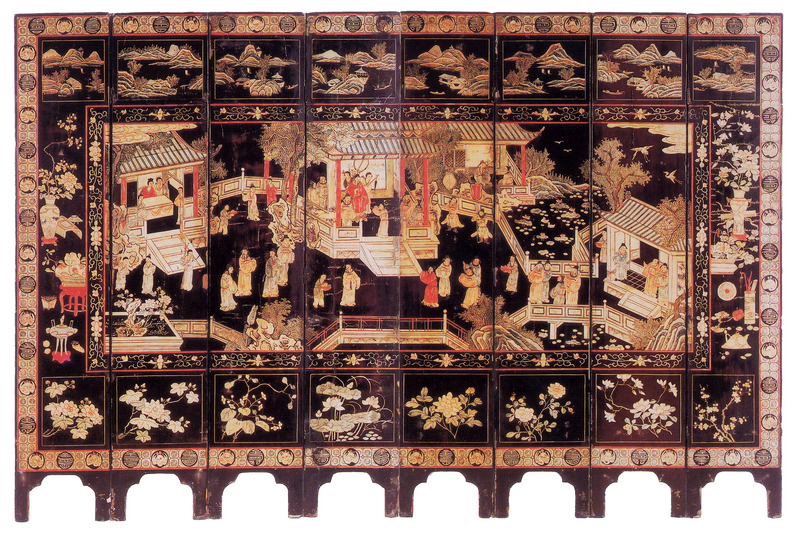
We also find this type of representation on18th-century fan leaves,
like those shown by Thomas DeLeo (op. cit, p. 28), which he dates from the last part of the
18th-century, or on another pair, referring to Qiu Ying (1494?- 1552)
but closer to 1800 (CPHB collection), a detail of which is reproduced below.
But let us come back to the leaf that motivates this question! Here is
a detail below. The leaf appears printed and perhaps even decorated
with light gouache (?). It is of course interesting to compare it to a
common "mandarin" fan leaf. The inspiration is obviously the same.
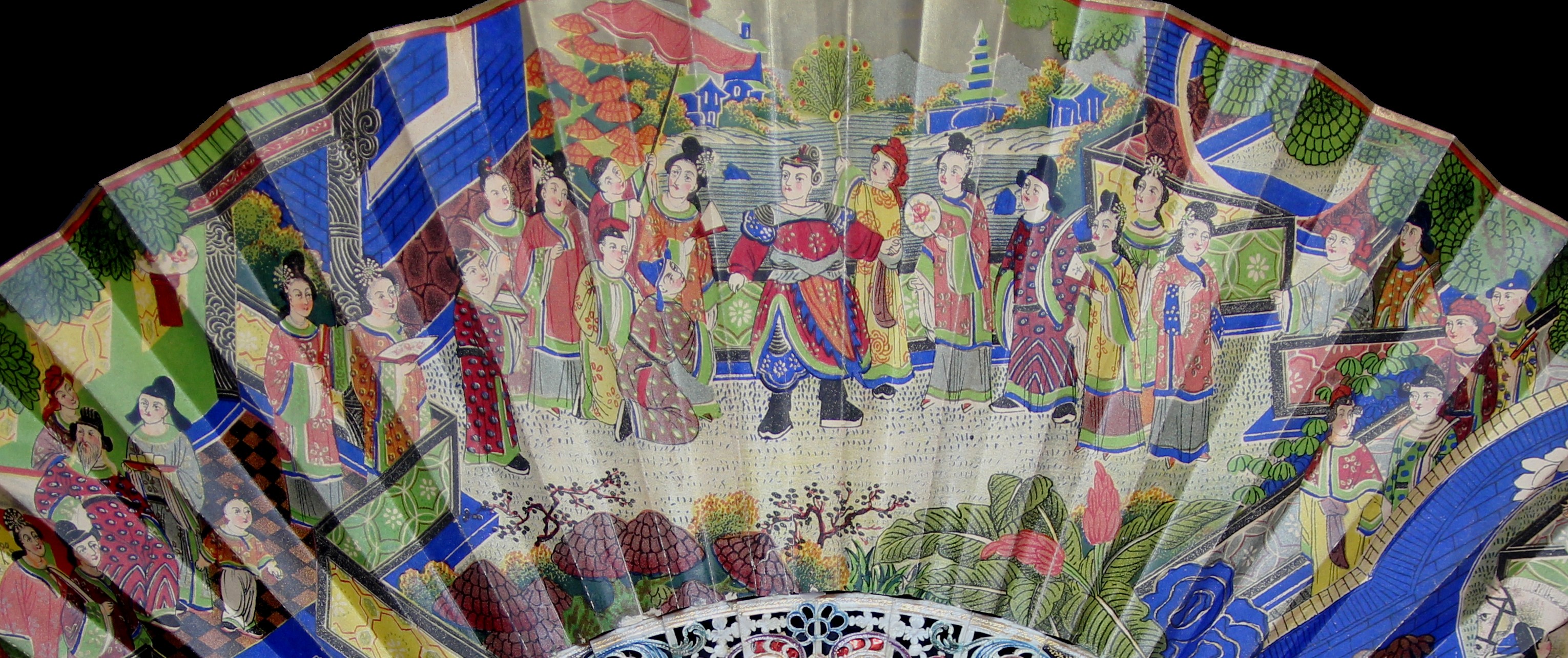
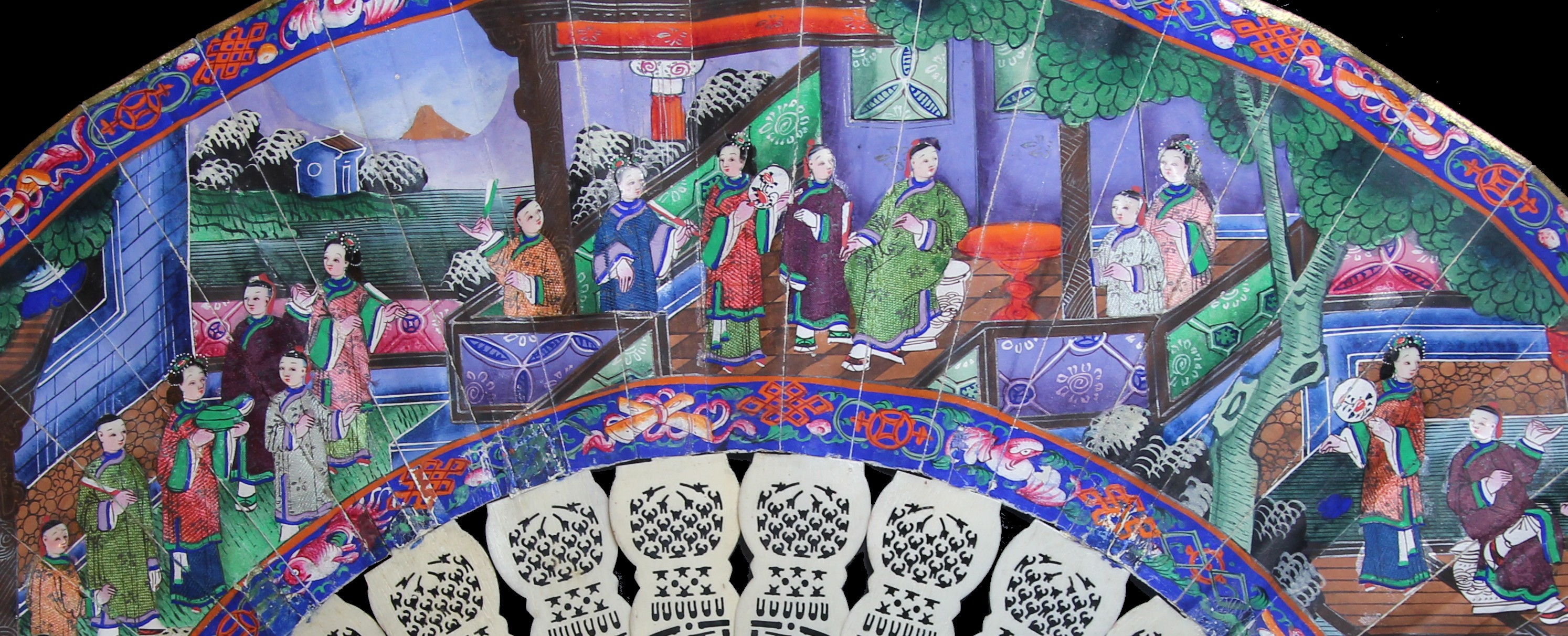
But what is it exactly? Which copies the
other? If the fan leaf with the c. 1760 monture was contemporary with it,
it is would be a rare prototype that could have served as a model for
"Mandarin" fans of the 19th century, just like the leaf after Qiu Ying
(?) shown above. If the "current mandarin" fan precedes the other leaf,
which seems more realistic, our fan is a very skilful and harmonious
marriage between mid-18th century European sticks and guards and an
equally European chinoiserie leaf a hundred years younger. Thomas
DeLeo, in the article cited above, shows (p.39, photo below) an European chinoiserie leaf married
around 1870 to a monture dating from the 1770s or 80s. He also shows (p.
38, other photo below) below), an
advertisement for a Spanish house offering Mandarin-style leaves as
soon as 1853.
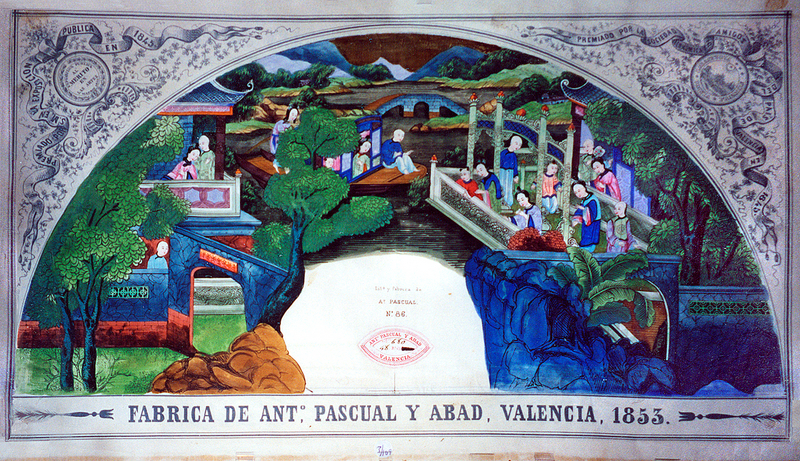 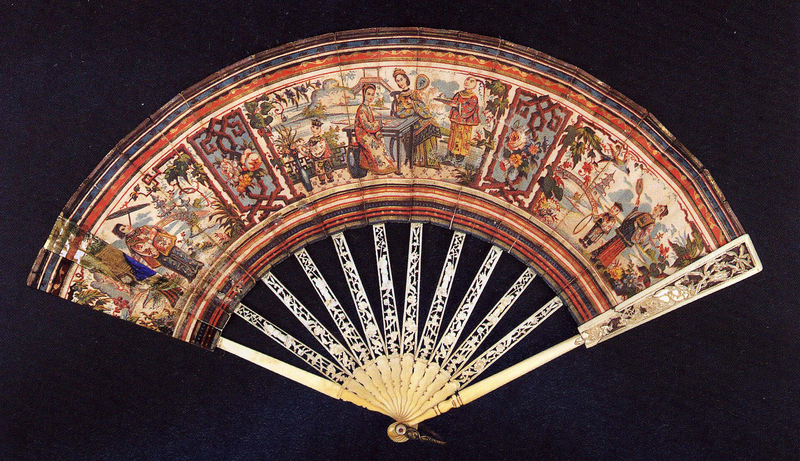
Looking at the reverse of our fan, we are not much further ahead. This
trendy bird (a crested lapwing?) corresponds well by its style to what
is often found on the verso of certain Chinese fans, which Thomas DeLeo
linked to the school of Macau. This reverse is obviously
chromolithographed. While working on this subject, I found a similar
fan (see below) which appears in the catalog Chine -Chinoiseriesau château de Maisons,
an excellent exhibition (November 2005 to January 2006) organized by
the late Michel Maignan and the Cercle
de l'Eventail. This was, I think, the last opportunity we had to
meet Rae, the dear Tom DeLeo's companion. This fan, lent by Lucie
Saboudjian (expert and well-known specialized merchant) appears p. 107
under n° 72. The monture is
said to be Chinese from the beginning of the 19th century, and the
double chromolithographed leaf from the end of the century. If the
reverse is totally different from the one we show, it is of the same
inspiration. As for the leaf, it has a border that does not exist on
our fan; but the essentials seem identical .
Alas, the quality of the photos does not allow a definitive conclusion.
The marriage between a beautiful 18th century monture and a much later
printed leaf remains very interesting. Were these fans mass marketed?
By which fanmaker? Do you have other fans with this same leaf? With
which reverse and what kind of sticks?... Can you give us your opinion
on the origin and the precise dating of these printed leaves? As you
can see, by appearing to answer the original question, I only prompted
new ones. Don't be afraid to make a mistake: you will never make it as
big as an auctioneer can do!
P.H.
B. décembre 2022
Thank you in advance for your contributions. Of course,
all other pieces of advice, opinions or questions are welcome!
|


